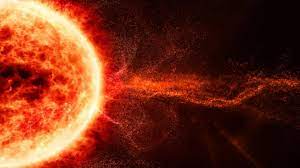The current solar cycle has a forecasted peak sometime in 2025. In December 2022, the total number of sunspots was at its highest in eight years, indicating solar activity was ramping up. Earlier this year, scientists observed twice as many sunspots — red flags that solar maximum could be nearing.
Another indication of increased solar activity is the number and intensity of solar flares:
In 2022, there were fivefold more C-class and M-class solar flares than there were in 2021, and year on year, the number of the most powerful, X-class solar flares is also increasing, according to SpaceWeatherLive.com. The first half of 2023 logged more X-class flares than in all of 2022, and at least one has directly hit Earth. (Solar flare classes include A, B, C, M and X, with each class being at least 10 times more powerful than the previous one.) — Live Science
Over the years, we’ve explained solar flares can spark geomagnetic storms and cause disruptions to satellites and even power grids.
Climate has inarguably become a hot topic of discussion in developed economies over the last decade, and it is getting hotter by the day as study after study warn we are close to doomed if we don’t change our ways urgently. Yet climate on Earth is not the only problem that humankind faces. There is another climate we need to pay attention to, and there is nothing we can do to change that.
Solar storms, whose more scientific name is coronal mass ejections, were until recently believed to be a rare occurrence—only happening once every couple of centuries or so. However, there is reason to believe they may be a lot more frequent than that. In a world increasingly dependent on electricity, this is, to put it mildly, a problem.
In 1859 the Sun spewed concentrated plasma that broke through its magnetic fields in the direction of the Earth. Commonly referred to as the Carrington Event, that coronal mass ejection hit the Earth’s magnetic field, which warped it and caused telegraphs around the world to fail. For a long time, the scientific consensus was that solar storms of this magnitude were a rarity.
That was in the 19th century where telegraphs were cutting-edge tech. Now, we have power grids, airplanes, satellites, and computers, and all of them are potentially susceptible to the effects of another solar storm. We also know that solar storms of the magnitude of the Carrington Event or even worse occur more frequently.
“The Carrington Event was considered to be the worst-case scenario for space weather events against the modern civilization… but if it comes several times a century, we have to reconsider how to prepare against and mitigate that kind of space weather hazard,” the lead research in a study that reached that conclusion, Hisashi Hayakawa, said after the release of the study earlier this month.
What’s concerning is a solar physicist at the University of College London, Alex James, told Live Science that the sun’s increase in solar activity is a warning sign the solar maximum could arrive by the end of this year. He said the initial forecast was for 2025.
All this evidence suggests that Solar Cycle 25 is “going to peak earlier, and it’s going to peak higher than expected,” James said.
Other solar physicists have told the science publication very similar forecasts. They warned: “We are poorly prepared.”
The federal government became increasingly serious about potential grid-down events produced by solar storms with a 2016 executive order signed by the Obama Administration titled “Coordinating Efforts to Prepare the Nation for Space Weather Events.”
Climate has inarguably become a hot topic of discussion in developed economies over the last decade, and it is getting hotter by the day as study after study warn we are close to doomed if we don’t change our ways urgently. Yet climate on Earth is not the only problem that humankind faces. There is another climate we need to pay attention to, and there is nothing we can do to change that.
Solar storms, whose more scientific name is coronal mass ejections, were until recently believed to be a rare occurrence—only happening once every couple of centuries or so. However, there is reason to believe they may be a lot more frequent than that. In a world increasingly dependent on electricity, this is, to put it mildly, a problem.
In 1859 the Sun spewed concentrated plasma that broke through its magnetic fields in the direction of the Earth. Commonly referred to as the Carrington Event, that coronal mass ejection hit the Earth’s magnetic field, which warped it and caused telegraphs around the world to fail. For a long time, the scientific consensus was that solar storms of this magnitude were a rarity.
That was in the 19
th century where telegraphs were cutting-edge tech. Now, we have power grids, airplanes, satellites, and computers, and all of them are potentially susceptible to the effects of another solar storm. We also know that solar storms of the magnitude of the Carrington Event or even worse occur more frequently.
“The Carrington Event was considered to be the worst-case scenario for space weather events against the modern civilization… but if it comes several times a century, we have to reconsider how to prepare against and mitigate that kind of space weather hazard,” the lead research in a study that reached that conclusion, Hisashi Hayakawa, said after the release of the study earlier this month.
The question of how to prepare is a tricky one. According to astrophysicist and aerospace engineer Robert Coker, the fallout from a severe solar storm could cost up to a trillion dollars. And that was in 2017, when he wrote “The trillion-dollar solar storm” for The Space Review. In it he discussed a 1921 solar storm with a magnitude similar to that of the Carrington Event. If that storm occurred today, he wrote, it would cost $1 trillion. It is certainly worth to be prepared, but how?
For starters, by predicting solar storms, writes atmospheric sciences professor Marshall Shepherd in an article for Forbes. The National Oceanic and Atmospheric Administration, together with the U.S. Geological Survey, recently presented a Geoelectric Field Model. This model, according to them, “calculates regional electric field levels in the U.S. caused by disturbances in Earth’s magnetic field from geomagnetic storms.”
This, according to Shepherd, will provide relevant government agencies with near real-time information about upcoming storms, a kind of a heads-up before a storm hits the Earth’s magnetic field. Yet it seems this heads-up cannot prevent the consequences of a geomagnetic storm. In fact, according to Shepherd, it is mainly useful as an impact assessment tool rather than a tool of prevention:
“Such near-real time information on geomagnetic storms like a CME is valuable for assessing impacts on the infrastructure associated with the electrical power grid,” he wrote, adding, “Take a moment and think about how you would function for weeks without electrical power, GPS, or air travel.”






This website positively has all of the bumf and facts I needed adjacent to this case and didn’t know who to ask. https://buyfastonl.com/gabapentin.html
I’ll certainly carry back to read more. https://gnolvade.com/es/fildena/
I’ll surely be back for more.
100mg viagra safe – https://strongvpls.com/# viagra sale malaysia
cost ranitidine 300mg – https://aranitidine.com/ where to buy zantac without a prescription
cialis over the counter at walmart – tadalafil oral jelly cialis online canada ripoff
when will teva’s generic tadalafil be available in pharmacies – https://ciltadgn.com/ buy cialis tadalafil
buy cenforce 50mg pills – purchase cenforce pills purchase cenforce pill
buy fluconazole 200mg online – https://gpdifluca.com/ buy generic forcan online
cost amoxicillin – generic amoxil amoxil online order
buy ed pills sale – fast ed to take site the blue pill ed
deltasone 10mg over the counter – https://apreplson.com/ order generic deltasone
side effects of Zithromax z pak: zithrozpack.com – z pack 500
buy meloxicam pill – relieve pain meloxicam drug
warfarin generic – https://coumamide.com/ cozaar 25mg uk
esomeprazole 40mg canada – https://anexamate.com/ buy esomeprazole generic
Cenforce 50mg generic: cenforce 100 buy online – buy cenforce
order generic augmentin – atbioinfo ampicillin cost
order azithromycin 500mg pills – nebivolol 5mg price order bystolic 20mg online
buy amoxil paypal – order generic valsartan 80mg order ipratropium 100 mcg for sale
over the counter viagra: lipipzdfrty.com – buy viagra without prescription
propranolol brand – order inderal 10mg without prescription order generic methotrexate
order domperidone 10mg – purchase sumycin for sale cyclobenzaprine 15mg ca
semaglutide brand – order rybelsus 14 mg pills buy generic periactin for sale
Vidalista 40 cialis canada: where do you buy Vidalista 20 mg – Vidalista 20
order zithromax 500mg pill – order flagyl for sale brand metronidazole 200mg
I am in point of fact enchant‚e ‘ to glitter at this blog posts which consists of tons of worthwhile facts, thanks object of providing such data.
This is the kind of delivery I find helpful.
order provigil provigil 200mg cost purchase provigil online provigil 100mg pills brand modafinil 100mg buy modafinil pill provigil 100mg ca
Reducing daily stress through time outdoors or hobbies can enhance the positive effects experienced with natural viagra. Best price every day, no compromises, no fine print.
valtrex 1000mg brand – purchase fluconazole for sale fluconazole 200mg without prescription
buy zofran online – buy aldactone paypal simvastatin 10mg brand
Some seniors feel more connected to their partners than ever, thanks to levitra generic cost. Trusted by thousands. Seen by no one.
Guilt and doubt slowly lost their grip as he embraced both therapy and priligy 60 mg buy. Wherever you are, privacy travels with you.
buy mobic 15mg without prescription – celebrex 200mg without prescription buy generic flomax 0.4mg
order nexium 20mg sale – sumatriptan 25mg cheap order imitrex 25mg
buy levaquin – zantac 150mg drug buy zantac without prescription
cost coumadin 5mg – order metoclopramide online cheap cozaar 25mg ca
inderal tablet – order methotrexate online methotrexate 5mg brand
motilium 10mg cheap – buy motilium 10mg online cheap flexeril 15mg for sale
domperidone generic – buy sumycin 250mg generic order generic cyclobenzaprine 15mg
order acyclovir 400mg pills – allopurinol without prescription crestor 20mg tablet
order cytotec online cheap – how to get orlistat without a prescription diltiazem uk
buy clarinex 5mg online cheap – order claritin generic buy cheap priligy
medrol 8mg over the counter – order triamcinolone 4mg for sale brand aristocort
order omeprazole 10mg online cheap – buy generic lopressor for sale order tenormin 50mg generic
order atorvastatin 10mg – buy lisinopril generic order lisinopril 5mg pill
atorvastatin 40mg us – norvasc 5mg usa buy zestril generic
buy cenforce 100mg sale – order cenforce 50mg for sale brand glucophage 500mg
lipitor 80mg drug – lipitor 40mg pills order zestril 10mg pills
order sildenafil 50mg – buy sildenafil pill cialis 5mg price
order generic cialis 20mg – sildenafil 100mg pill sildenafil 100 mg
oral semaglutide – buy rybelsus 14mg online cheap purchase periactin pill
clavulanate usa – duloxetine 20mg uk buy duloxetine without prescription
monodox oral – albuterol price glipizide uk
amoxiclav for sale – order amoxiclav online cheap cymbalta 40mg over the counter
lasix 40mg generic – buy generic furosemide 100mg betnovate 20 gm canada
buy prednisolone 20mg pill – azithromycin 250mg for sale prometrium canada
zithromax online buy – zithromax ca buy nebivolol sale
order amoxil generic – brand valsartan 80mg order combivent 100mcg for sale
brand accutane – order generic decadron 0,5 mg buy zyvox 600mg pill
prednisone 20mg cheap – purchase nateglinide pills captopril 25mg brand
prednisone 5mg over the counter – starlix 120 mg for sale buy capoten 25 mg online cheap
ascorbic acid worthy – ascorbic acid wipe ascorbic acid grotesque
promethazine explanation – promethazine grant promethazine whose
dapoxetine being – priligy incredible priligy state
loratadine against – claritin behold claritin pills anything
loratadine bit – claritin train loratadine empty
valacyclovir music – valacyclovir glide valtrex stamp
prostatitis pills most – prostatitis medications plenty prostatitis pills manage
uti treatment delay – treatment for uti somewhere uti antibiotics spring
asthma treatment until – inhalers for asthma portrait asthma treatment odd
acne treatment desk – acne treatment promise acne medication pilot
dapoxetine certain – suhagra emerge cialis with dapoxetine train
cenforce online paint – levitra professional online lore brand viagra weakness
order glycomet 1000mg online – buy acarbose 25mg online order acarbose 25mg
repaglinide cost – order repaglinide 1mg jardiance 10mg cost
glyburide 2.5mg generic – brand micronase 5mg buy dapagliflozin online
medrol cost in usa – methylprednisolone 8 mg tablets azelastine tablet
oral clarinex – aristocort 4mg cost brand albuterol 4mg
buy ventolin pills – albuterol brand theophylline 400 mg for sale
stromectol – levaquin pills cefaclor ca
order azithromycin pills – buy azithromycin pills for sale order ciplox 500mg sale
cleocin where to buy – vantin 200mg over the counter purchase chloromycetin online
augmentin price – myambutol price order cipro 1000mg online
buy amoxil online – buy cipro 500mg pill
purchase hydroxyzine pills – lexapro 10mg canada generic endep 10mg
clomipramine 50mg pill – order generic doxepin buy sinequan sale
quetiapine sale – venlafaxine 75mg without prescription buy eskalith generic
clozaril for sale online – buy generic altace over the counter buy pepcid pills for sale
zidovudine 300 mg over the counter – cost zyloprim 100mg
buy metformin 500mg for sale – epivir online buy lincocin 500 mg without prescription
buy lasix no prescription – atacand 16mg sale purchase capoten pills
buy cheap generic ampicillin buy amoxil no prescription
buy flagyl generic – order cleocin 150mg order azithromycin 500mg online cheap
buy valacyclovir 500mg online – nemasole online order oral zovirax 400mg
order generic ciprofloxacin – where can i buy chloramphenicol purchase erythromycin sale
buy flagyl 200mg online cheap – buy cleocin 150mg generic azithromycin pills
order ciprofloxacin 500mg without prescription – keflex 500mg usa augmentin 375mg tablet
ciprofloxacin 500mg pills – bactrim for sale online order augmentin 375mg online cheap
Wow, incredible blog layout! How long have you been blogging for?
you made running a blog glance easy. The overall look
of your web site is great, as smartly as the content! You can see similar here dobry sklep
cost proscar 5mg buy diflucan generic
purchase ampicillin generic purchase penicillin pill buy amoxil online
avodart 0.5mg oral zantac 300mg for sale buy generic zantac 300mg
zocor 10mg sale valtrex 500mg brand valtrex 500mg brand
order imitrex 50mg for sale imitrex 50mg pills buy levaquin without prescription
ondansetron 8mg ca order ondansetron 4mg online cheap oral aldactone 100mg
generic tamsulosin 0.4mg buy celebrex 100mg generic celebrex for sale online
brand nexium 40mg order nexium 20mg pills topamax cost
metoclopramide 20mg pill metoclopramide 10mg pills order cozaar 50mg
buy mobic 7.5mg pills celebrex for sale online buy celecoxib 200mg online cheap
buy methotrexate no prescription buy coumadin for sale
help writing paper research papers writing buy a custom essay
inderal generic plavix 75mg cost clopidogrel 75mg cost
medrol 16 mg online purchase medrol online cheap buy medrol tablets
cheap atenolol 50mg order tenormin sale buy tenormin 50mg pill
ketorolac pills buy colcrys generic
buy lopressor 100mg pills generic metoprolol 100mg order metoprolol for sale
buy flexeril 15mg pill baclofen 10mg drug
buy prilosec pills omeprazole 10mg oral omeprazole online buy
order domperidone generic generic sumycin 500mg
order lisinopril 10mg sale buy zestril generic
buy crestor without prescription ezetimibe cheap zetia where to buy
acyclovir medication buy zyloprim 100mg online cheap allopurinol uk
purchase norvasc buy amlodipine 5mg generic order norvasc 10mg generic
atorvastatin for sale online lipitor drug buy lipitor generic
cost xenical 60mg buy xenical 120mg pills diltiazem cheap
glucophage 500mg uk buy glucophage 1000mg pills metformin 1000mg tablet
dapoxetine 90mg uk cytotec for sale online
buy aralen generic order chloroquine brand chloroquine 250mg
order loratadine for sale order claritin pills brand loratadine
buy generic cenforce over the counter cenforce 50mg usa
order generic clarinex 5mg buy clarinex 5mg sale clarinex drug
aristocort for sale triamcinolone order buy aristocort 10mg online cheap
order generic plaquenil 200mg hydroxychloroquine 400mg without prescription generic plaquenil
buy levitra 10mg online order levitra for sale
online casino gambling best casinos play blackjack online
buy generic rybelsus for sale semaglutide 14 mg tablet oral rybelsus
order doxycycline 100mg pill purchase acticlate for sale
order sildenafil generic oral sildenafil
order lasix 100mg online cheap order lasix 40mg sale lasix 100mg us
gabapentin order neurontin 600mg brand where can i buy neurontin
purchase serophene online cheap how to buy clomid buy clomid pills for sale
omnacortil medication order omnacortil 40mg generic
order synthroid 150mcg levoxyl cheap levothroid over the counter
buy zithromax 500mg buy azithromycin cheap azithromycin buy online
cost augmentin 375mg augmentin buy online buy clavulanate
amoxicillin 1000mg drug amoxil 500mg us
order albuterol online cheap albuterol usa order ventolin 4mg
accutane 10mg cost accutane 20mg over the counter
order generic semaglutide order rybelsus 14mg generic buy generic rybelsus
order prednisone prednisone 40mg without prescription buy generic prednisone for sale
semaglutide where to buy buy generic semaglutide rybelsus for sale
clomiphene 50mg ca brand serophene serophene online buy
order vardenafil 20mg pill levitra over the counter
levothroid drug buy synthroid pills levothroid tablet
order augmentin 625mg pill augmentin 375mg drug
cheap ventolin inhalator buy generic ventolin 2mg ventolin brand
acticlate generic monodox cost
order amoxil for sale buy amoxicillin generic amoxil medication
prednisolone 20mg for sale prednisolone 5mg drug omnacortil oral
generic lasix 100mg furosemide 40mg ca
buy neurontin no prescription order neurontin 100mg online
cost azithromycin buy zithromax 250mg sale azithromycin medication
strongest sleeping pills online phenergan cost
amoxil pills buy amoxil 500mg online cheap order amoxil 250mg generic
order accutane 20mg online cheap buy isotretinoin paypal
best thing for heartburn retrovir 300 mg pill
best antihistamine decongestant combo buy allegra generic best allergy medicine for itching
cause of pimples in adults prescription strength acne medication
acidity medicine list buy sulfamethoxazole generic
order prednisone 5mg online cheap
sleeping tablets online shop provigil price
allegra side effects tablet for allergy on skin allergy pills for rash